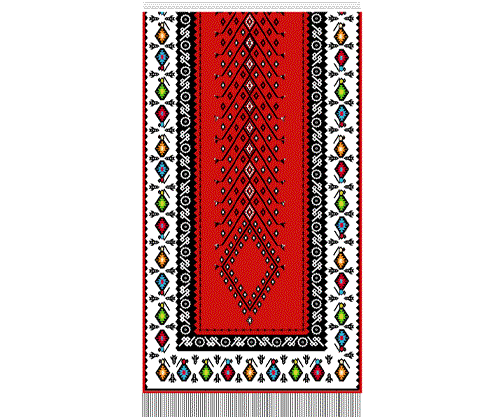
Date
Fall 2008
Place
The Hague, Netherlands
Medium
mixed media (hand-woven wool kilim, prayer beads, booklets)
Design context
Produced for the group show Since We Last Spoke About Monuments at The Stroom Den Haag / 14 Sep. - 09 Nov. 2008 / Curated by Mihnea Mircan
Concept and design
Azra Akšamija
Conceptual contributions
Khadija Z. Carroll, Mihnea Mircan, Dietmar Offenhuber, Alex Schweder, Amila Smajović
Consulting in pattern design
Amila Smajović (artist and kilim expert from Sarajevo)
Kilim manufacture
STILL-A Sarajevo (owner A. Smajović, www.stilla.ba)
Thanks to
Ibrahim and Munira Aksamija, project participants, conceptual contributors, project producers, interview partners, Center for Islamic Architecture at the Rijaset Sarajevo, Gerhard Diermoser, Asja Mandić, Dietmar Offenhuber, András J. Riedlmayer, Andreas Spiegl, kilim weavers, and the team of The Stroom.
Monument in Waiting
Monument in Waiting is a collective testimony of the ‘ethnic cleansing’ in Bosnia-Herzegovina, carried out by nationalist extremists during the war of 1992-95. This process of territorial and cultural ‘decontamination’ involved the eviction and mass murder of civilians, as well as the extermination of their cultural and historical traces. Places of worship being particularly targeted, destroying the previous period of peaceful co-habitation. While all ethnicities suffered destruction or damage of their cultural heritage, the quantity of destroyed mosques far outweighs the number of destroyed churches. The pattern of this hand-woven kilim tells the story of the systematic devastation of Islamic cultural heritage during the war and points at the impact of this human and cultural catastrophe on the Bosniaks’ religious, ethnic, and national identities today.
The project started with the historical and archival research of 250 out of over 1000 mosques that have been deliberately damaged or destroyed by nationalist extremists during the war. Nine case studies were chosen for a more detailed investigation. Interviews with a range of individuals engaged in the current mosque building and rebuilding process gave insight into individual war experiences, mosque histories and stylistic choices for new designs. The research material was then abstracted as kilim symbols. Each kilim symbol is thus encoded with both personal memories and historical facts, and their interweaving makes visible the collective memory of the Bosniaks’ war experience. Such a collective design process enabled the translation of the traditional Bosnian kilim iconography into a contemporary context – locally found patterns and symbols were converted into signifiers of political, military aggression and threatened collectivity, while providing a multitude of outlooks into the future of the Bosniak nation. Acknowledging that the International Criminal Tribunal for the former Yugoslavia has recognized the destruction of religious architecture as evidence of a targeted annihilation of Bosnian multiculturalism, this kilim is waiting to be displayed in the ICTY, where it will actualize its function as a monument.
The kilim was produced in collaboration with Amila Smajović and her Sarajevo based workshop “STILL-A,” which employs refugee women as weavers. Three kilim borders, which usually symbolize levels of ‘cleansing’ and ‘protection’ of the central kilim surface, are inspired by the Afghan war rugs. They are filled with traditional local motifs, transformed into weapon-like symbols to describe the Bosnian war. The three borders siege the central composition with the ‘tree of life’ motif, the metaphor of the paradise garden and eternal afterlife. This tree tells the main kilim story. Each tree branch carries symbols that represent abstracted data and stories about the investigated mosques. By providing directionality in reading, the central composition shapes a double mihrab, an indicator of the Mecca direction. The top of the kilim is intentionally left unfinished to indicate the continuing process towards closure through therapeutic means such as weaving, and that working to restore the architectural and emotional devastation in Bosnia-Herzegovina could become an endless process. The initiation of this process is visually communicated through the motif of the growing ‘tree of life’, to which new branches with new stories can be woven. Yet, these stories would need to encompass all the destroyed mosques, churches, and all other lost monuments in Bosnia-Herzegovina. While the completion of this project remains utopian, the ritual hanging of the 99 prayer beads onto the kilim edge symbolically launches the process.